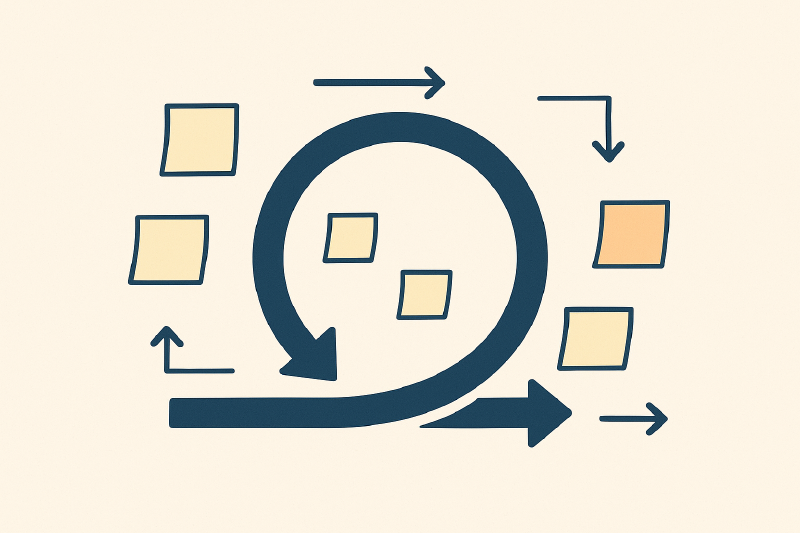Embracing Iterative Requirement Development in Product Ownership
“The definition of insanity is doing the same thing over and over again and expecting different results.”
— Attributed to Einstein
The Myth of Up-Front Certainty
As a Product Owner, one of the most common questions I get is:
“How do you manage requirement development in an Agile way?”
It’s a fair question — traditional product requirement processes often assume you can capture everything upfront, get it signed off, and hand it over to developers like a blueprint for a house.
This old-school approach typically follows these steps:
- Plan the analysis approach
- Elicit requirements
- Analyse and design the solution
- Prioritise the requirements
- Get approval and sign-off
Once finalized, these requirements are passed along to the development team, with the expectation that the resulting product will match the original vision.
But here’s the problem: this process almost never works in software.
According to the CHAOS Report by the Standish Group, projects that follow this linear model consistently underperform — and many outright fail.
What Experience Has Taught Us
Years of building software products have made a few truths crystal clear:
- You can’t know everything at the beginning.
- Requirements will change.
- Written requirements are always subject to interpretation.
Despite our desire for predictability, software development is inherently complex and uncertain. Efforts to impose rigid plans often backfire, introducing waste, rework, and stakeholder frustration.
Instead of trying to predict the future, successful product teams embrace empiricism — the practice of making decisions based on what is, rather than what we hope will happen.
“Empiricism means working in a fact-based, experience-based, and evidence-based manner.”
— Scrum.org: The Three Pillars of Empiricism
Predictability vs Progress
In traditional settings, predictability is prized. But demanding it in uncertain environments leads to a dangerous illusion of control.
“We work in an uncertain world, and our main goal in pursuing agility is to confront the unknown… Pursuing predictability causes us to lay a veneer of fiction over the real world.”
— Scrum.org: Escaping the Predictability Trap
This is why Agile frameworks such as Scrum promote short feedback loops, continuous learning, and transparent decision-making. It allows Product Owners to continuously refine and reprioritize based on:
- Actual user feedback
- Technical insights
- Market signals
In this model, the product backlog is a living document, not a requirements bible.
Iterative Requirement Development in Practice
So how should Product Owners approach requirements in this dynamic environment?
Instead of detailed specs for a year’s worth of work, aim for just enough clarity — at just the right time.
A healthy product backlog typically contains:
- 2–3 sprints worth of refined stories
- Lightly defined epics for the next quarter
- High-level ideas for future exploration
This model aligns with the Cone of Uncertainty — a concept that acknowledges we know the least at the beginning of a project and gradually gain clarity through discovery and iteration.
By delaying commitment until the last responsible moment, teams can:
- Minimize waste
- Reduce rework
- Respond quickly to change
The Role of Discovery and Up-Front Analysis
Does this mean we abandon up-front planning altogether?
Absolutely not.
Good Product Ownership requires thoughtful discovery work — especially at the outset of new initiatives. The key is to balance early analysis with flexibility.
Marty Cagan’s concept of Product Discovery offers a powerful framework for this. Discovery involves defining the right problems to solve, validating solutions with customers, and aligning stakeholders — all before investing in development.
“The purpose of product discovery is to quickly separate the good ideas from the bad. We don’t want to build things customers won’t use or that won’t work for the business.”
— Marty Cagan, SVPG
Not every part of a product requires the same depth of analysis. Skilled Product Owners must evaluate:
- What’s known and stable (requiring less detail)
- What’s unknown or risky (requiring deeper investigation)
This risk-based approach to discovery ensures we invest time where it matters most.
Final Thoughts: Empiricism is Empowering
When Product Owners embrace iterative, empirical requirement development, they create the conditions for:
- Better alignment with end users
- More resilient roadmaps
- Higher-value outcomes
- Stronger partnerships with development teams
We stop pretending we know the future and instead build the capability to respond to it.
As Agile manifesto co-author Mike Cohn puts it:
“We want to delay decisions until the last responsible moment to preserve flexibility and avoid unnecessary work.”
If you’re still clinging to thick BRDs and waterfall mindsets in your product practice, it’s time to evolve.
Additional Reading
- The Three Pillars of Empiricism in Scrum – Scrum.org
- Escaping the Predictability Trap – Scrum.org
- CHAOS Report – Standish Group
- Cone of Uncertainty – Agile Alliance
- Nature of Product Discovery – SVPG
- Dual-Track Agile – Marty Cagan, SVPG
